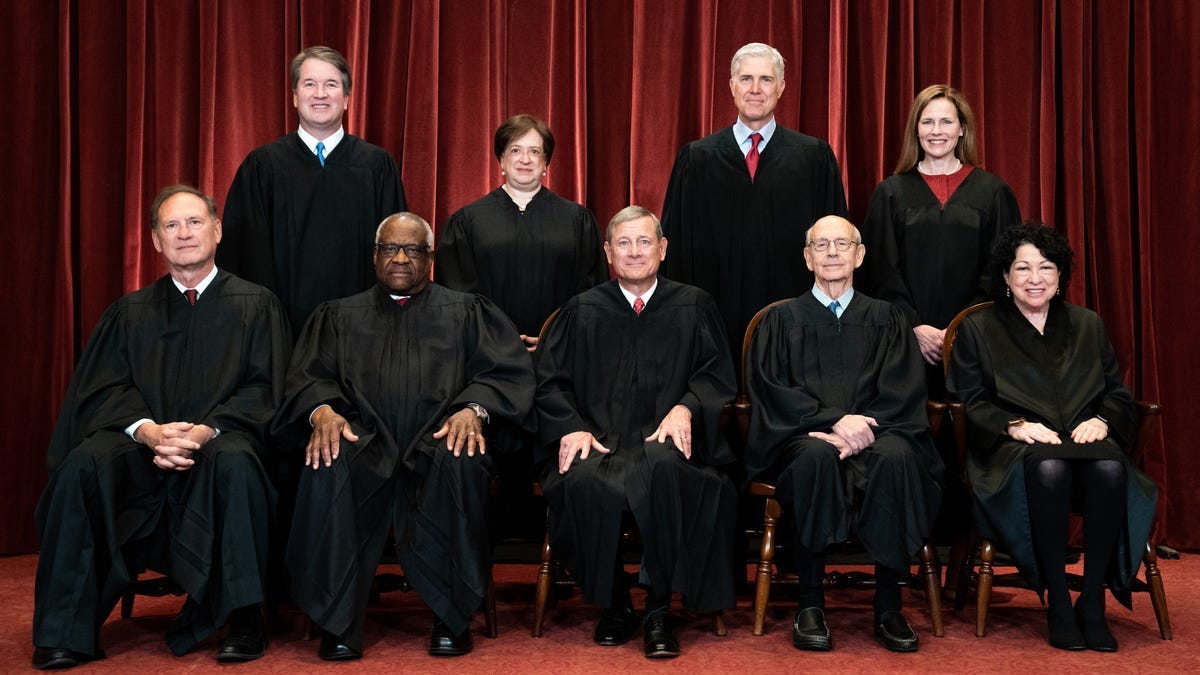The Supreme Court is in the news again what with Justice Stephen Breyer’s announcement that he will step down at the end of this term. This vacancy gives President Biden a chance to replace him with a like-minded judge, keeping the current 6-3 split between conservatives and liberals. Starting with the Merrick Garland fiasco, and continuing through the Kavanaugh hearings and the railroading of Amy Coney Barret to replace Justice Ginsburg, a national conversation (more like a brouhaha) has taken place about whether and how to reform the Court. I introduced the theory and practice of democracy by lottery with my previous post on politics. In a footnote to that piece, I mentioned how we might use lotteries to improve the selection process for judges. Let me flesh that proposal out a bit more.
The appointment route to the Court that we now have suffers from severe cognitive dissonance. On the one hand, everybody knows it’s a political process and that all judges have an ideology. The President nominates the candidate, so he naturally looks for jurists who share his constitutional philosophy. Both parties do this. And yet at the same time, there’s this sense among all involved that the Court should be balanced and impartial, not partisan.
This leads to the farce in which an ideologue, chosen by another ideologue, goes before the Judiciary Committee and claims to be nothing but a neutral arbiter of legal disputes. John Roberts insisted, famously, that he had no judicial philosophy—he just called balls and strikes. Almost all the other justices, conservative or liberal, spoke likewise at their hearings. Presumably, Biden’s nominee will issue the same disclaimer. But once on the bench, these people immediately issue decisions that betray a strong constitutional interpretation.
Of course they do—they’re legal scholars and political appointees. It’s only natural they evince a worldview. Yet when the Court makes divisive rulings, like about the Texas abortion law last summer and fall, the justices take to the lecture circuit and insist with a straight face that they’re not partisan. Breyer did so himself in a recent book tour, trying to deny what we all know: they’re politicians in robes. Erudite, learned, and intellectual as they may be, it’s just a fact that they read constitutional cases through a particular hermeneutic. How else do you explain why the same judges vote together on hot-button cases? We should stop this charade that the Court’s above philosophical differences—that just peddles the myth that this anti-democratic tribunal is some august body.
At the same time, we all recognize that while the people picked are inevitably political, the process for choosing them really should strive for impartiality. The judges may not be neutral, but the bench as a whole ought to be. The confirmation wars are killing us. It’s not only bad for the system, but also bad for our mental health. Nothing stokes polarization like the battle for the Court, a zero-sum, winner-take-all cage match. So how can we serve both realities? How can we pick ideological judges in a fair way that leads to a balanced Court? I’m not an expert, but here’s where I think lotteries could help us.
Imagine we rewrite the Constitution to create a new, democratic process for judicial appointment. Here I draw from Simon Threlkeld’s ideas. It could go something like this: first, a lottery is held to create a citizens’ panel of everyday Americans. This panel would constitute a representative sample of the population, reflecting what the entire country would think if we were all in the same room. It would be politically diverse, with a mix of liberals, moderates, and conservatives correlating to the percentage of Americans who have those leanings.
Next, the panel would create three pools of judicial candidates: one conservative, one moderate, one liberal. They’d then work together and with the aid of experts to research, vet, and choose candidates for each pool. These candidates would be picked for several traits. First, merit. The panel would look for the best and the brightest legal minds in the land. Liberated from partisan games, they could expand their horizons beyond the usual suspects. Scholars, civil servants, litigators, and more could all be considered.
Second, political worldview. Instead of having candidates deny their ideological leanings, they would be open about them. Candidates of the left would go into the left’s pool. Candidates of the right would go in the right’s pool. Candidates of the center would go in the moderate’s pool. The panel would have to reach consensus—or at least a super-majority—about each candidate, breathing stability into the process. The result would be three large pools of candidates—I’m thinking in the hundreds—all qualified to hear Federal cases, and grouped by ideology.
The final phase would deploy a second set of lotteries to pick the justices. Given that most High Courts around the world are much larger than ours, I agree that we should expand the Supreme Court to, say, 27 members. One lottery would then choose 9 justices out of the left pool; another would choose 9 of the center; and the third would choose 9 of the right. This would create a balanced Court through a fair, impartial process. It would add an element of chance—what the Greeks called “fate”—to the outcome, preventing corruption and stacking the Court one way or another. Yet it also ensures an inevitable result. That is, no one could predetermine which justices gets picked, yet the Court would boast an even divide between liberals, moderates, and conservatives no matter what.
Sound crazy? Maybe. Still, it strikes me as more sane than the status quo. But wait: it gets wilder. How long should justices serve? Lifetime-tenures are terrible, a relic of monarchy that should be abolished. Ok, but what kind of term limits should we impose? Reformers float different numbers: 16 years, 12 years, 10 years. I have an even more radical proposal: 0 years. You read that right. Why should any one person serve on the Court for a predetermined length of time? When people get seated on a Court for a term, even just a year, that entices them to harden their ideological preferences. It also affords them the power to shape Federal law single-handedly through a series of decisions. Giving just 9 or 27 men and women that kind of authority is dangerous. The ancient Athenians would warn us that even a year on the Court could allow oligarchic tendencies to fester.
So what’s my proposal? Hear me out. The candidates in the judicial pools would be placed in them for life. This would make them eligible for being selected for cases over their career, but they would go about their day jobs as normal. Each year, lotteries would be conducted by the citizens’ panel (whose composition would reset every time) to choose judges for individual cases that term. In other words, the citizens’ panel would know in advance that, in this term, 200 cases have been selected to go before the Court (the current average is 75 a year, but with a much larger pool of judges, that could expand). It would then conduct 200 lotteries from the predetermined pool of candidates, picking 27 names for each case—9 liberals, 9 moderates, 9 conservatives.
The candidates chosen would be informed of their selection and would report to the Court on the day the case is scheduled (like jury duty). They’d get the briefings in advance, of course, so as to prepare. Then they’d hear oral argument, deliberate in chambers, come to consensus (or vote), and assign someone to write the decision—just like now. Afterwards, they’d head back to their regular lives (as professors or lawyers or whatever) and their names would return to the pool for next year’s case lotteries.
We could, if we liked, impose a limit on how many cases a given person could serve on in his or her lifetime. There are a lot of options. But the chief virtue here is it allows a diversity of legal minds to hear cases and prevents a small coterie from capturing the Court—even for one term. At the same time, it ensures that no matter what, the parties coming before the Court know they must argue before a balanced bench. This would stop the pernicious “court watching” that goes on now, in which lawyers read the justices’ behavior and comments for which cases to bring and how they intend to rule.
It would also increase the likelihood that the justices would issue careful, narrow rulings instead of sweeping, divisive ones. Because the bench would be evenly divided between conservatives, progressives, and centrists, the judges on the right or left would have to win over the moderates to get a majority. This would incentivize radicals on either end of the spectrum to move to the center, resulting in middle of the road decisions that garner broad support. You could even urge the judges to work toward consensus—a novel idea. This would promote stability over the long haul and breed balanced rulings that most Americans could live with.
As for who determines the cases that go before the Court each term, that could be handled by a separate panel of either everyday people or lower-level judges (the way Melody Wang argues it should be done). As with the judges themselves, the cases could be picked by a combination of vetting and lottery—the panel could research and create a pool of worthy cases, then use a lottery to pick a set number to be heard each year.
In addition to the reform of the selection process, the Court’s power must be shrunk to what it was originally. The Framers gave little thought to the Court and it was a joke in its early years. Congress was supposed to be the center of government, not the President or the judiciary. Even after John Marshall expanded the Court’s authority, it had limited power and was not considered to have the last word on anything. Lincoln completely ignored the Dred Scott decision, for example, and kneecapped the Court.
Today, the Supreme Court is an imperial force, up there with the Presidency, even as Congress’s power has shrunk. I believe we should adopt a variety of measures to cut the Court down to size, of the kind that scholars Ryan Doerfler and Samuel Moyn propose. For example, we could strip the Court of jurisdiction over certain areas. We could require a supermajority of justices in order to strike down Federal legislation (say, 18 out of 27). And we could give the legislature the power to override a decision of the Court through a supermajority of its own.
All this is a lot to process, I realize. But think on it. These reforms would provide a salutary check to the Court. Combined with the lottery-based selection method, it would lead to a more democratic judicial system. It would have the added bonus of promoting egalitarian decisions. Historically, the Court has been on the side of big business and stymied progressive efforts to build social and economic democracy, like the New Deal. Having everyday people pick the candidates, and eliminating terms of office, could break this elite capture. At the very least, it would take the edge off our toxic Court fights and repair a broken process. It wouldn’t be immaculate. But let’s not make the perfect the enemy of the better.









Wow I thought of a lottery too and I researched and say this information. Also know person is allowed to have any legal issues noted against them at all . They would be disqualified to be a Justice.
I think a citizens' assembly is probably the wrong venue for picking judges. Most citizens don't know much about the law or the judicial process, which is no slight to them, they have their own affairs to tend to. But it would mean that the assembly would be practically paralyzed without experts and consultants to hold their hands, which (unless the citizens did decide to go it alone, likely leading to poor, uninformed decision making) would ultimately leave the process reliant on whatever small group of consultants, or worse, media figures, has the ear of these randomly selected citizens. That's even less democratic than the present system.